Search Results
Filters
Advanced Search
2175 Results
-

Power Aware Verification
Track - Apr 05, 2013 by Erich Marschner
This track introduces the IEEE Std 1801 Unified Power Format (UPF) for specification of active power management architectures and covers the use of UPF in simulation-based power aware verification.
-
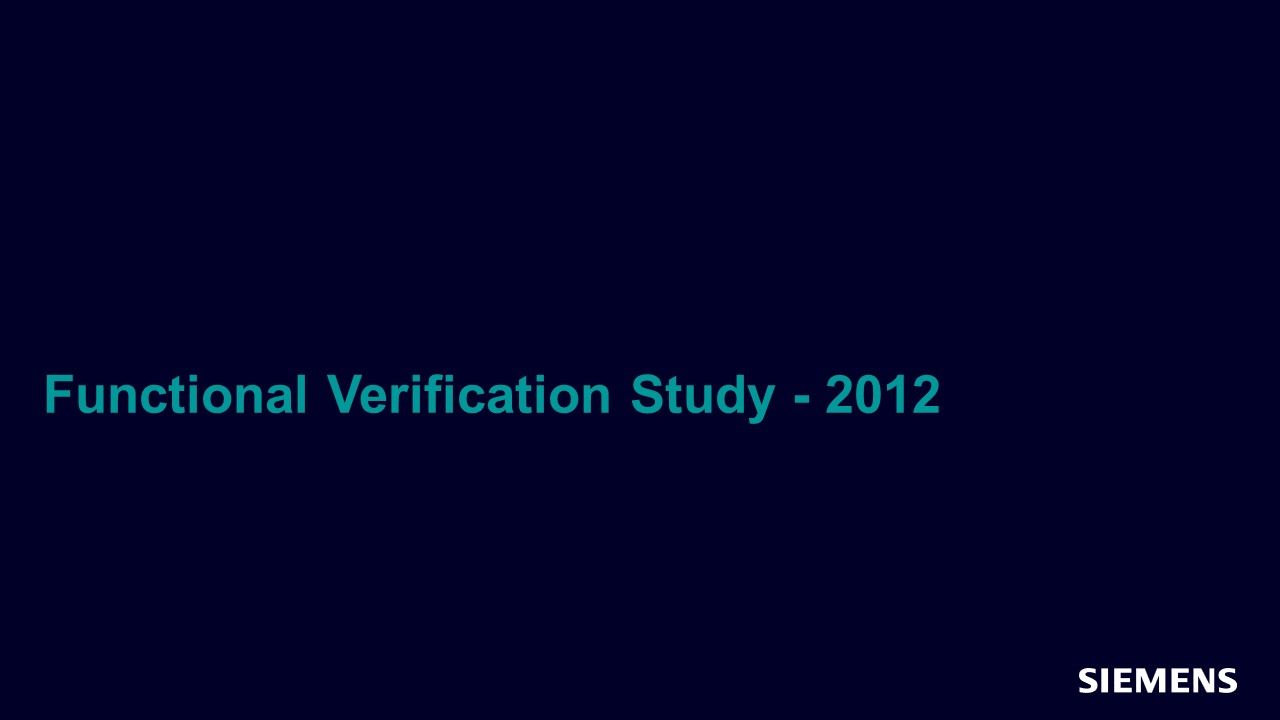
Functional Verification Study - 2012
Session - Apr 01, 2013 by Harry Foster
In this session, Harry Foster highlights the key findings from the 2012 Wilson Research Group Functional Verification Study, and provides his interpretation and analysis behind today's emerging trends.
-
UVM 1.1d Class Reference
Resource (Reference Documentation) - Mar 07, 2013 by
v1.1d The UVM Class Library provides the building blocks needed to quickly develop well-constructed and reusable verification components and test environments in SystemVerilog. This UVM Class Reference provides detailed reference information for each user-visible class in the UVM library. For additional information on using UVM, see the UVM User’s Guide located in the top level directory within the UVM kit.
-

Boost Verification Results by Bridging the Hardware/Software Testbench Gap
Paper - Feb 27, 2013 by Matthew Ballance
Today's complex designs increasingly include at least one, and often more, embedded processors. Given software's increasing role in the overall design functionality, it has become increasingly important to leverage the embedded processors in verifying hardware/software interactions during system-level verification. This paper presents a UVM-based package for software-driven verification and presents applications of this package that enable more-comprehensive system-level verification.
-

Register Verification: Do We Have Reliable Specification?
Paper - Feb 27, 2013 by Wesley Park - Siemens EDA
Traditional register verification uses simulation to check IP compliance with a manually written specification. In this paper, we introduce a register model that overcomes limitations in the expressiveness of the predefined UVM and IPXACT access polices. We will also present results from the successful application of our method to the register verification of three industrial designs.
-
Register Verification: Do We Have Reliable Specification?
Resource (Paper (.PDF)) - Feb 27, 2013 by Wesley Park - Siemens EDA
In this paper, we introduce a register model that overcomes limitations in the expressiveness of the predefined UVM and IPXACT access polices. We will also present results from the successful application of our method to the register verification of three industrial designs.
-
Boost Verification Results by Bridging the Hardware/Software Testbench Gap
Resource (Paper (.PDF)) - Feb 27, 2013 by Matthew Ballance
This paper presents a UVM-based package for software-driven verification and presents applications of this package that enable more-comprehensive system-level verification.
-
Methodology Enhancements used on a Next Generation Weather Satellite C&DH Program
Resource (Paper (.PDF)) - Feb 27, 2013 by Mike Horn
With parameterized agents, driver level data rate controls and timing controls in addition to utilizing the broad capabilities of OVM and UVM, the GOES-R C&DH team produced FPGAs that performed admirably in the lab.
-

Methodology Enhancements used on a Next Generation Weather Satellite C&DH Program
Paper - Feb 27, 2013 by Mike Horn
In 2010–2011, Lockheed Martin Space Systems designed and verified eight FPGAs for the Command and Data Handling (C&DH) subsystem of the NOAA/NASA Geostationary Operational Environmental Satellite R-Series (GOES-R), scheduled to launch in 2015. Hardware validation and integration of these FPGAs went smoothly. Perhaps the best measure of the success: the FPGAs performed with almost no functional failures during integration and test.
-
Transaction-Level Friending: Connecting TLM Models in SystemC and SystemVerilog
Resource (Recording) - Feb 27, 2013 by Adam Erickson
UVM Connect bridges the SystemC and SystemVerilog language boundary to provide seamless TLM1 and TLM2 connectivity between components residing in those two languages.
-
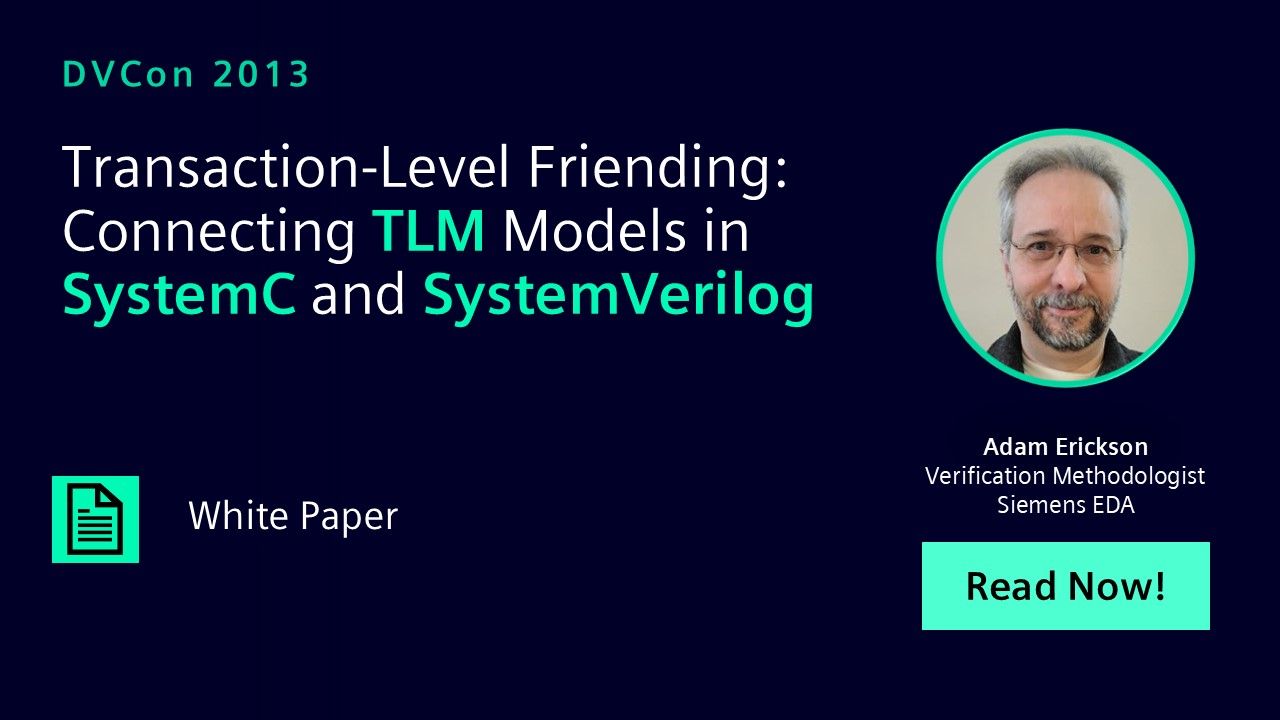
Transaction-Level Friending: Connecting TLM Models in SystemC and SystemVerilog
Paper - Feb 27, 2013 by Adam Erickson
This paper describes the purpose, requirements, development challenges, and applications of an open-source library for establishing standard TLM-based communication between SystemC (SC) and SystemVerilog (SV) models, including C/C++ models wrapped in SC or SV. It also describes a SystemC-side interface for controlling simulations based on the UVM in SystemVerilog. The UVM Connect library is available for download and has been proven to work on three major EDA vendors’ simulators. 1
-
Traffic Profiling and Performance Instrumentation For On-Chip Interconnects
Resource (Paper (.PDF)) - Feb 26, 2013 by Mark Peryer
This paper describes a proposal for the specification of bus master traffic profiles and system level traffic scenarios, together with the definition of performance metrics that need to be instrumented to ensure that an interconnect is meeting its performance targets.
-
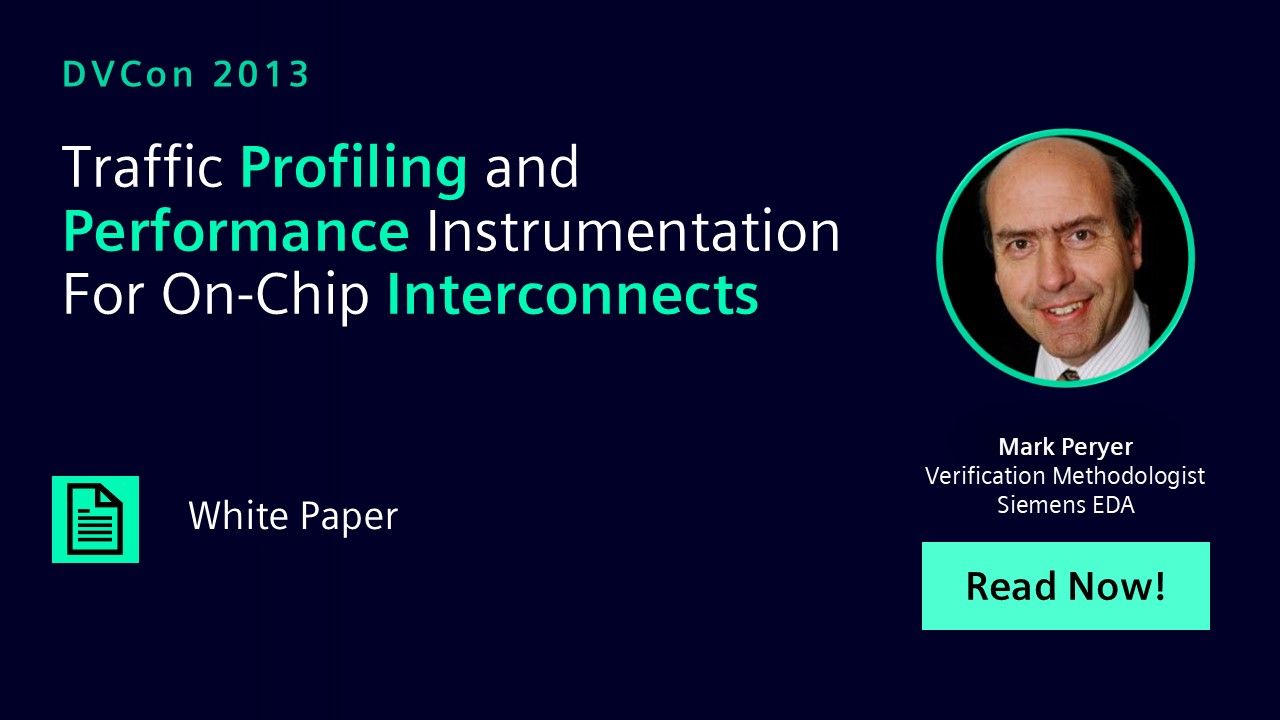
Traffic Profiling and Performance Instrumentation For On-Chip Interconnects
Paper - Feb 26, 2013 by Mark Peryer
On-chip bus interconnect fabrics have become critical sub-systems in SoC platforms. Not only do they need to be functionally correct, but they also need to deliver the performance demanded by user applications. This paper describes a proposal for the specification of bus master traffic profiles and system level traffic scenarios, together with the definition of performance metrics that need to be instrumented to ensure that an interconnect is meeting its performance targets.
-
Seven Separate Sequence Styles Speed Stimulus Scenarios
Resource (Paper (.PDF)) - Feb 26, 2013 by Mark Peryer
This paper describes seven common sequence design patterns which should prove useful to all UVM sequence writers. These patterns can be used stand-alone or combined to solve practical stimulus generation problems using UVM sequences.
-

Sequence, Sequence on the Wall: Who's the Fairest of Them All?
Paper - Feb 26, 2013 by Rich Edelman
The reader of this paper is interested to use UVM sequences to achieve his test writing goals. Examples of UVM sequences will be used to demonstrate basic and advanced techniques for creating interesting, reusable sequences and tests.
-
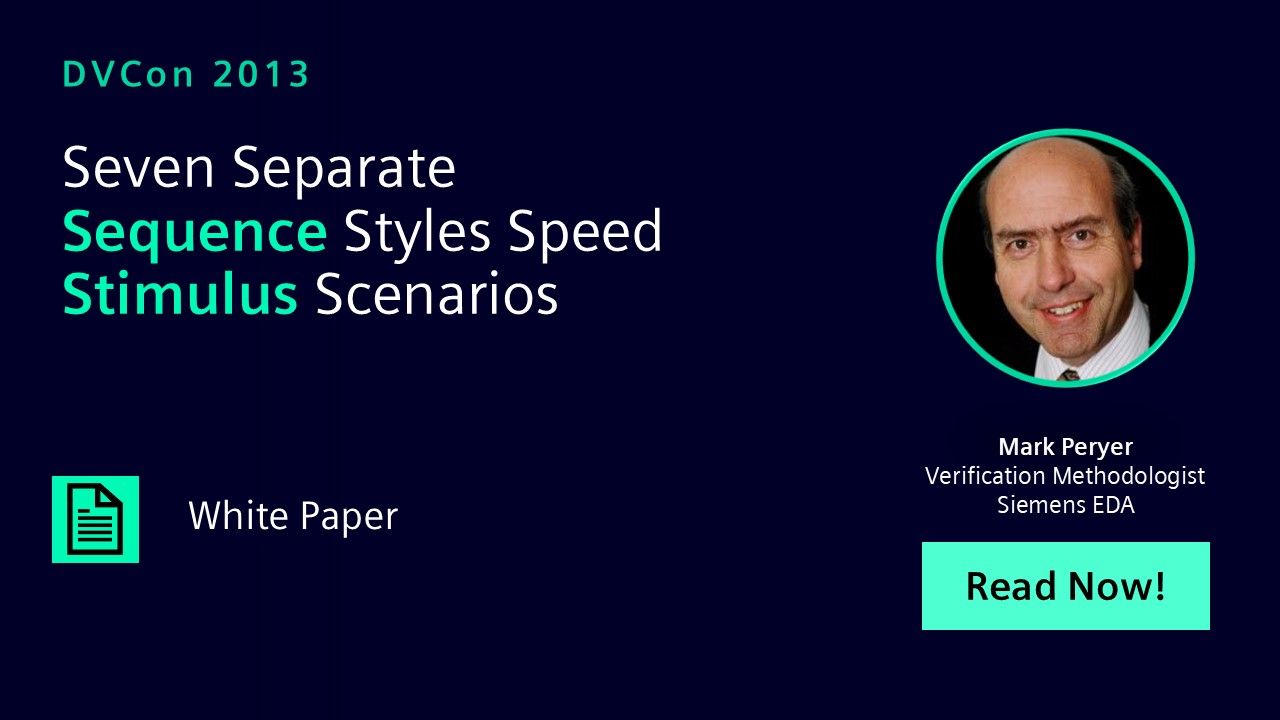
Seven Separate Sequence Styles Speed Stimulus Scenarios
Paper - Feb 26, 2013 by Mark Peryer
Writing effective stimulus in UVM can prove to be challenging for various reasons, but not knowing about the relevant coding design patterns should not be one of them. There are various alternative techniques for writing sequences and choosing the right approach requires mastery of several styles. This paper describes seven common sequence design patterns which should prove useful to all UVM sequence writers.
-
Boosting Simulation Performance of UVM Registers in High Performance Systems
Resource (Paper (.PDF)) - Feb 26, 2013 by Ahmed Yehia - Siemens EDA
In the paper, we give a quick overview of the UVM register library on how it could be used to model and verify hardware registers and memory blocks, showing the simulation performance bottlenecks observed when performing on high-speed buses.
-

Boosting Simulation Performance of UVM Registers in High Performance Systems
Paper - Feb 26, 2013 by Ahmed Yehia - Siemens EDA
In the paper, we give a quick overview of the UVM register library on how it could be used to model and verify hardware registers and memory blocks, showing the simulation performance bottlenecks observed when performing on high-speed buses. We then present an efficient overlay layer that can be easily integrated on top of the UVM register library, making the library suitable for high as well as low performance systems.
-
Monitors, Monitors Everywhere: Who Is Monitoring the Monitors
Resource (Paper (.PDF)) - Feb 26, 2013 by Rich Edelman
In a verification environment the task of a monitor is to monitor activity on a set of DUT pins. This could be as simple as looking at READ/WRITE pins or as complex as a complete protocol bus, such as AXI or PCIe. In a very simple case a monitor can be looking at a pin or a set of pins and generating an event or raising a flag every time there is a change in signal values. The flag or event can trigger a scoreboard or coverage collector to perform an activity.
-
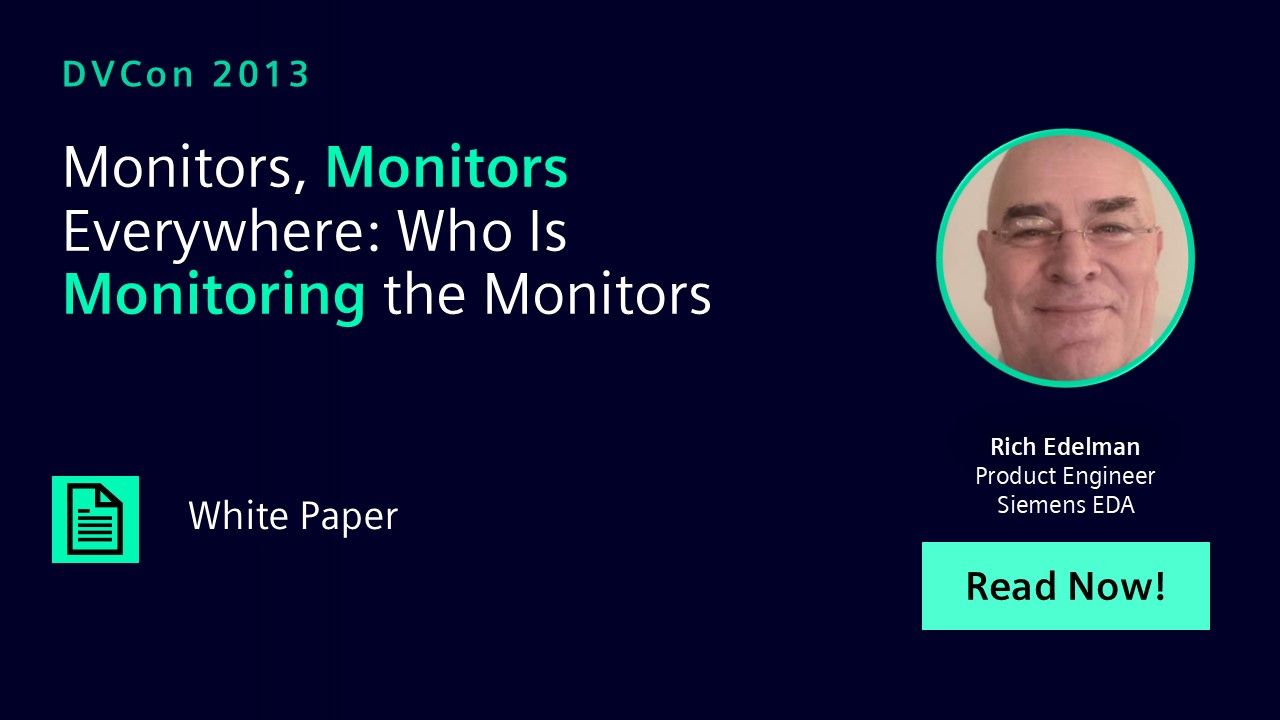
Monitors, Monitors Everywhere: Who Is Monitoring the Monitors
Paper - Feb 26, 2013 by Rich Edelman
The reader of this paper should be interested in predicting the behavior of his hardware or is interested in monitoring his hardware. This paper will review phase-level monitoring, transaction-level monitoring, and general monitoring. In-order and out-of-order transaction-level monitors and UVM constructs for single and multiple port monitors will be demonstrated, including discussion about simple function implementations versus FIFO and threaded implementations.
-
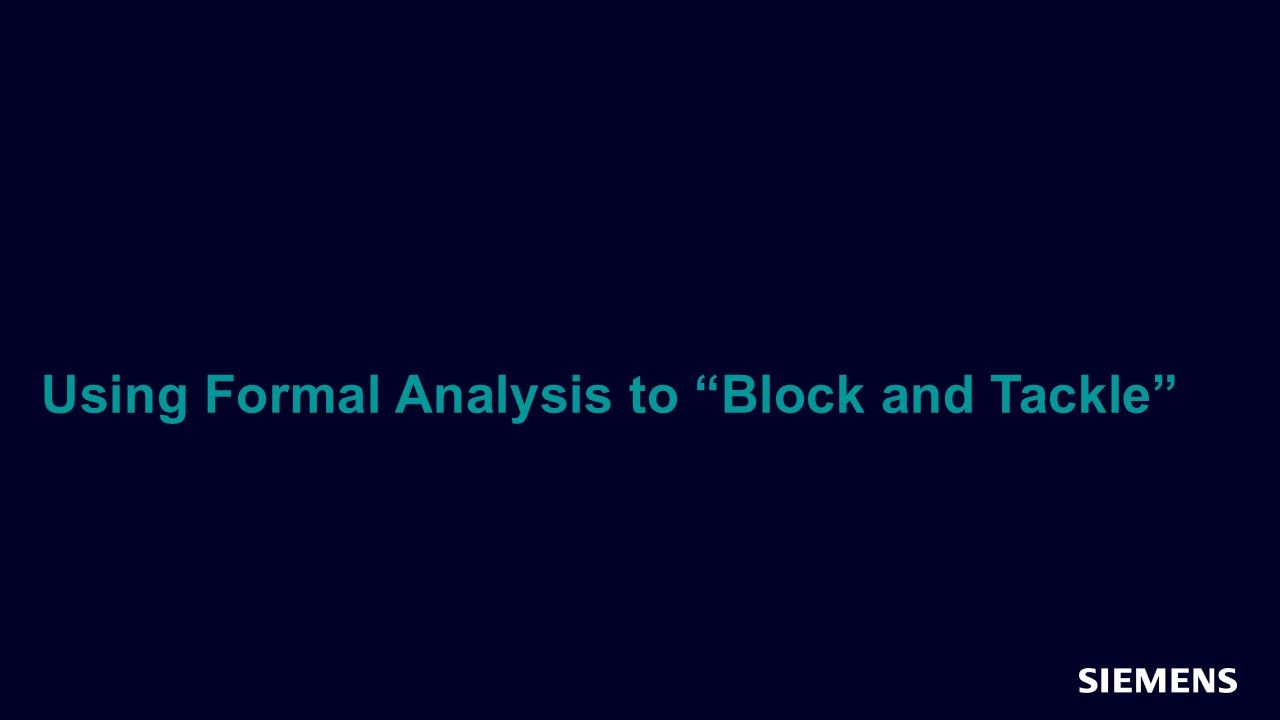
Using Formal Analysis to Block and Tackle
Article - Feb 25, 2013 by Paul B. Egan - Rockwell Automation
This article will explain how we applied formal analysis at the block level, extended this to full chip and describe how we significantly reduced verification time at both the block and chip level. Just like a block and tackle provides a mechanical advantage, the formal connectivity flow provides a verification advantage
-

Bringing Verification and Validation under One Umbrella
Article - Feb 25, 2013 by Hans Van Der Schoot
The standard practice of developing RTL verification and validation platforms as separate flows, forgoes large opportunities to improve productivity and quality that could be gained through the sharing of modules and methods between the two. Bringing these two flows together would save an immense amount of duplicate effort and time while reducing the introduction of errors, because less code needs to be developed and maintained.
-
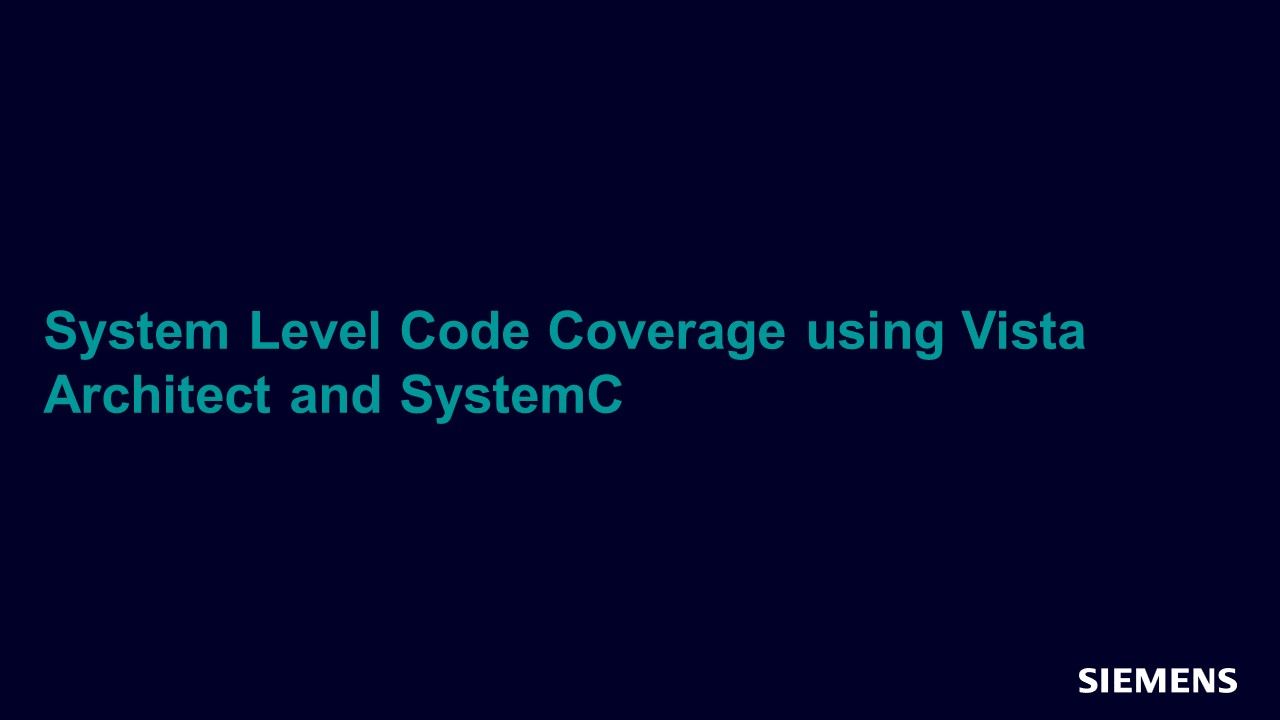
System Level Code Coverage using Vista Architect and SystemC
Article - Feb 25, 2013 by Ken P. McCarty - Siemens EDA
SoC are constantly becoming more and more complex forcing design teams to eke out as much performance as possible just to stay competitive. Design teams need to get it right from the start and can't wait until it's built to find out how it truly performs. This is where System Level Modeling and SystemC/TLM shine.
-

The Evolution of UPF: What’s Next?
Article - Feb 25, 2013 by Erich Marschner
Usage of the Unified Power Format (UPF) is growing rapidly as low power design and verification becomes increasingly necessary. In parallel, the UPF standard has continued to evolve. A previous article1 described and compared the initial UPF standard, defined by Accellera, and the more recent IEEE 1801-2009 UPF standard, also known as UPF 2.0. The IEEE definition of UPF is the current version of the standard, at least for now, but that is about to change.
-

Top Five Reasons Why Every DV Engineer Will Love the Latest SystemVerilog 2012 Features
Article - Feb 25, 2013 by Ajeetha Kumari, Srinivasan Venkataramanan - CVC Pvt. Ltd.
SystemVerilog has become the most widely deployed Verification language over the last several years. Starting with the early Accellera release of 3.1a standard, the first IEEE 1800-2005 standard fueled the widespread adoption in tools and user base. Since 2005 there is no look-back to this "all encompassing" standard that tries to satisfy and do more for RTL Designers and Verification engineers alike.